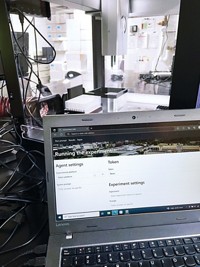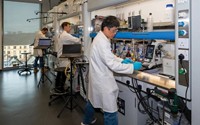Advertisement
Grab your lab coat. Let's get started
Welcome!
Welcome!
Create an account below to get 6 C&EN articles per month, receive newsletters and more - all free.
It seems this is your first time logging in online. Please enter the following information to continue.
As an ACS member you automatically get access to this site. All we need is few more details to create your reading experience.
Not you? Sign in with a different account.
Not you? Sign in with a different account.
ERROR 1
ERROR 1
ERROR 2
ERROR 2
ERROR 2
ERROR 2
ERROR 2
Password and Confirm password must match.
If you have an ACS member number, please enter it here so we can link this account to your membership. (optional)
ERROR 2
ACS values your privacy. By submitting your information, you are gaining access to C&EN and subscribing to our weekly newsletter. We use the information you provide to make your reading experience better, and we will never sell your data to third party members.
Informatics
IBM debuts chemical synthesis robot
RoboRXN can plan its own moves to synthesize a target chemical
by Craig Bettenhausen
September 2, 2020
| A version of this story appeared in
Volume 98, Issue 34

Got a molecule in mind? Artificial intelligence-powered synthesis robots may soon take it from there. In a virtual event last week, IBM launched RoboRXN, a fully automated synthesis system. As project manager Teodoro Laino and his team discussed the platform, RoboRXN was in the background preparing a derivative of 3-bromobenzonitrile.
RoboRXN builds on IBM RXN for Chemistry, a free cloud-based software the firm launched in 2018 to predict the outcome of chemical reactions suggested by users. In 2019, Laino’s team added a retrosynthesis tool, enabling users to draw a molecule and have the software design a synthesis for it. Now, they’ve married that computational power with hardware, creating a robot that can execute the synthesis.
“With the RoboRXN technology, we are expecting to accelerate, profoundly, the way we do material discovery,” Laino said in a video accompanying the event.
Other groups have paired robots with AI-assisted synthesis planning, such as the the research nonprofit SRI International, which unveiled the SynFini system in January. What sets IBM’s system apart, Laino tells C&EN, is that the computer programs itself to carry the operation out, planning every injection, temperature change, shake, or swirl. It uses a routine he calls Smile2Actions, a reference to a chemical structure notation known as simplified molecular-input line-entry system, or SMILES. The system can also read text descriptions of synthetic methods and execute them (Nat. Commun. 2020, DOI: 10.1038/s41467-020-17266-6).
As of now, RoboRXN can handle up to five synthetic steps without human intervention. That covers a lot of molecular ground but could limit the system’s use on complex drug compounds. Extensive purifications, which are sometimes needed between synthetic steps, are also out of reach for the robot, though Laino says his team is working on it.
IBM hopes to offer RoboRXN on a fee-for-service basis soon and is looking for corporate partners to scale the system up. It plans to keep the reaction prediction and retrosynthesis tools available online for free.
Alán Aspuru-Guzik, a chemistry professor at the University of Toronto who studies machine learning, says IBM’s system is one of several that are bringing AI-powered synthesis closer to widespread adoption. “This is an important first step along the journey,” Aspuru-Guzik says. “Several groups in the world are working in the area and making rapid progress. Expect to hear from many, including us, in this space as well.”





Join the conversation
Contact the reporter
Submit a Letter to the Editor for publication
Engage with us on Twitter